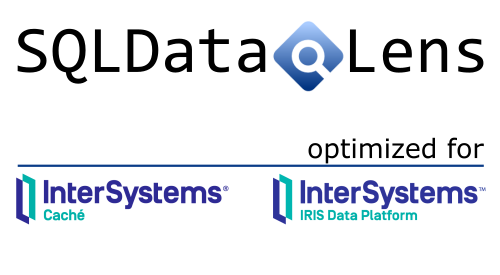As a dedicated InterSystems database developer, I’ve had the privilege of working with various tools and solutions over the years. But there’s one tool that has truly captured my heart and become an indispensable part of my toolkit: SQL Data Lens. In this blog post, I’d like to share my passion for SQL Data Lens and explain why it’s my preferred choice for working with InterSystems databases.
1. A Tailored Approach to InterSystems Database Development
One of the key reasons I adore SQL Data Lens is its tailored approach to InterSystems database management. Unlike generic database tools that try to be all things to all databases, SQL Data Lens is specifically designed to address the unique challenges and intricacies of InterSystems databases.
2. Seamless Integration with InterSystems Technologies
InterSystems is known for its diverse ecosystem, which includes Caché, IRIS, and other powerful technologies. SQL Data Lens seamlessly integrates with this ecosystem, offering a cohesive and efficient development experience. Whether I’m working with Caché or IRIS, I can trust that SQL Data Lens will support my efforts.
3. Advanced Query Building and Performance Optimization
As a developer, optimizing database queries is a top priority. SQL Data Lens not only simplifies the process of building complex queries but also provides robust performance tuning tools. This means I can fine-tune queries to achieve optimal database performance without the headache.
4. Industry-Specific Solutions
SQL Data Lens isn’t just a one-size-fits-all solution. It caters to specific industries and use cases. This flexibility is a game-changer, especially when working on projects in healthcare, finance, or other sectors with unique database requirements. SQL Data Lens adapts to my needs rather than forcing me to adapt to it.
5. User-Friendly Interface and Workflow
The user-friendly interface of SQL Data Lens has significantly improved my productivity. The intuitive design streamlines database development tasks, allowing me to focus on what matters most—designing and optimizing databases. It’s a tool that works with me, not against me.
6. Strong Community and Support
Database development can be challenging, but it’s reassuring to know that SQL Data Lens has a thriving user community and ample support resources. I’ve found answers to my questions, solutions to my challenges, and a sense of camaraderie among fellow developers who share my enthusiasm for this exceptional tool.
In conclusion, SQL Data Lens isn’t just a database management tool—it’s a partner in my InterSystems database development journey. Its tailored approach, seamless integration, advanced capabilities, industry-specific solutions, user-friendly design, and robust community support make it a true standout in the world of database development.
If you’re an InterSystems database developer like me, I encourage you to give SQL Data Lens a try. It may just become your new favorite tool, elevating your development experience and helping you achieve excellence in your projects.
Discover the power of SQL Data Lens and experience the joy of working with a tool that understands your unique needs as an InterSystems database developer.
(This is an experimental text generated by an AI chatbot)




